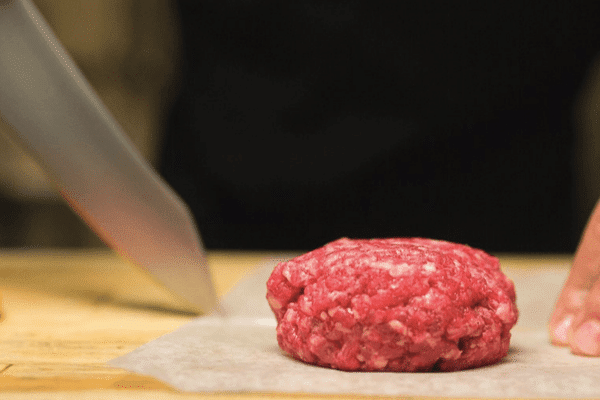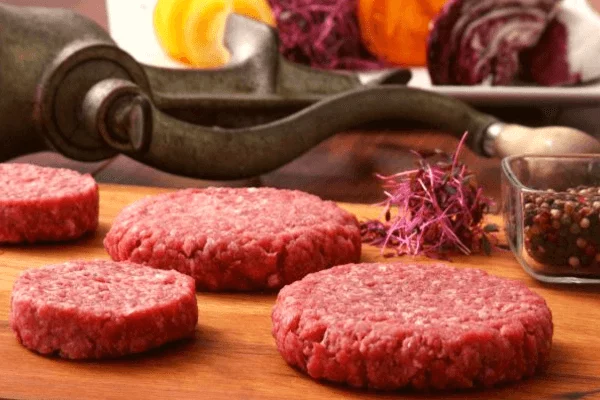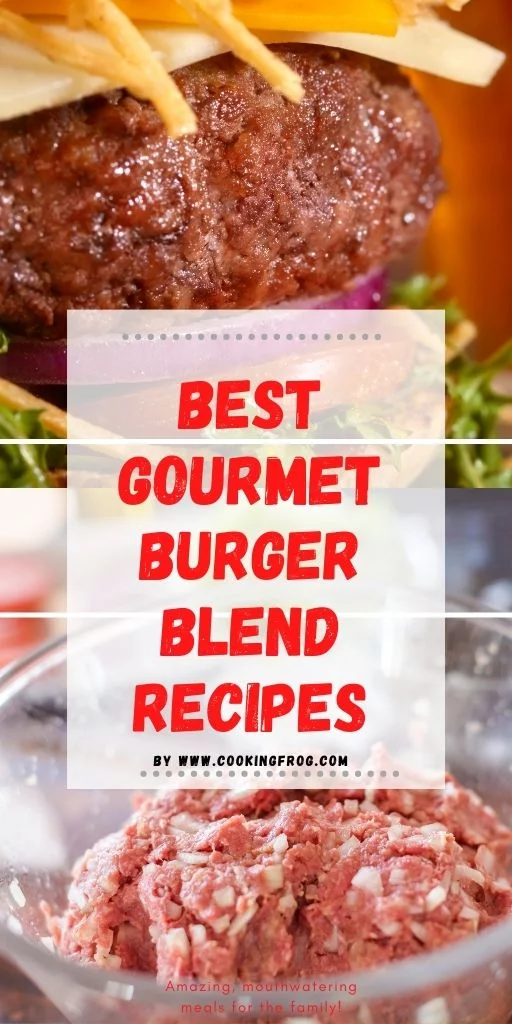If you’ve ever wondered what makes the perfect gourmet burger, the secret isn’t in the toppings — it’s in the blend. The protein-to-fat ratio, the cuts you choose, and the freshness of the grind all work together to create that juicy, flavorful burger you can’t stop thinking about.
I’m Sarah from Cooking Frog Recipes, and today we’re diving into the art of building the perfect patty. Whether you’re grilling for a summer cookout, hosting game day, or just craving a next-level burger, mastering your blend will make every bite unforgettable.
From the classic 80/20 chuck grind to creative mixes with brisket, rib, or sirloin, the possibilities are endless. The right combination gives you the tenderness, juiciness, and depth of flavor that take your burgers from ordinary to gourmet — no fancy restaurant required.
Ready to start grinding and blending like a pro? Let’s break down the best cuts of beef and how to combine them for the ultimate burger experience.

Building Your Own Burger Blend
Here’s a guide to the most popular beef cuts for grinding, their typical fat ratios, and the flavor they bring to your patties.
Chuck (80/20)
The gold standard of burger blends. When butchers talk about “hamburger,” they’re talking chuck. It’s a classic, well-balanced cut that produces a juicy, beefy burger without being overly greasy.
-
Pro Tip: Look for slabs labeled “chuck pot roast” and grind it fresh for unbeatable flavor.
Brisket (70/30)
Rich, flavorful, and a little rustic. Brisket adds a deep, beefy note and plenty of fat, giving your burger that melt-in-your-mouth texture with a hint of smokiness.
-
Best for: Blending with leaner cuts like round or flank for balance.
Rib (70/30)
Cuts like ribeye cap, flanken, or beef rib bring a luxurious, rich flavor and incredible tenderness to a burger. The high fat content creates a juicy, decadent bite.
-
Best for: Indulgent blends for special occasions.
Beef Plate (90/10)
Taken from the section just beneath the ribs, this cut yields skirt and hanger steaks. It’s leaner but packed with tangy, buttery flavor, perfect for a more sophisticated burger experience.
-
Best for: Blends that need an extra layer of complex flavor.
Short Loin (85/15)
If you’re feeling extravagant, try using a dry-aged New York strip from the short loin. The dry aging develops a rich, umami-packed profile you can’t get anywhere else.
-
Best for: Splurge-worthy burgers when you want to impress.
Flank (93/7)
Flank steak is lean but flavorful, with a beefy depth that works well when combined with fattier cuts. It’s a great way to add complexity without adding heaviness.
-
Best for: Blends where you want a cleaner, meat-forward taste.
Sirloin (85/15)
Sirloin varies widely depending on the section, but bottom sirloin is the sweet spot for burgers. It’s well-marbled and full of flavor, especially cuts like flap meat (steak tips) on the East Coast or tri-tip on the West Coast.
-
Best for: Everyday blends with a balance of flavor and tenderness.
Round (93/7)
Round cuts like top round, bottom round, or eye round are lean and affordable. They’re ideal when you need to adjust the fat content of a blend without changing the flavor profile too much.
-
Best for: Balancing fattier cuts like brisket or rib.
Shank (96/4)
Shank comes from the lower leg (hind or fore shank) and is beefy and gelatinous, though tough. A small amount added to your grind will melt into the patty, creating a tender, juicy bite with incredible depth.
-
Best for: Blends that need richness — just pair with a fattier cut to maintain balance.
Oxtail (85/15)
A bold choice that brings gelatinous, rich beefiness to your burger blend. It’s inexpensive, high in fat, and loaded with flavor. Oxtail requires more prep but rewards you with a burger that’s anything but ordinary.
-
Best for: Creative blends when you want to experiment with something unique.
Pro Tips for Grinding Beef
-
Chill everything: Cold meat and grinder parts make a cleaner grind and better texture.
-
Grind twice: For the best texture, grind coarse first, then medium.
-
Mix gently: Overmixing compacts the meat and leads to dense patties.
-
Cook with care: Handle patties gently and never press down on them while cooking — you’ll lose all the juices.
Create Your Own Signature Burger Mix
Once you’ve nailed the perfect grind, don’t be afraid to get creative with flavors. Mixing in a few simple ingredients can take your burger patties in a completely new direction. Here are some ideas to inspire your next cookout:
-
Thai-Inspired: Add a splash of soy sauce, minced garlic, creamy peanut butter, and a squeeze of lime juice for a savory-sweet patty with a subtle tang.
-
Fresh and Zesty: Mix in chopped cilantro, diced peppers, tomatoes, and onions for a bright, garden-fresh burger.
-
Breakfast-Style: Fold in shredded cheese, a beaten egg, and crumbled bacon for a rich, hearty twist.
-
Pizza Burger: Combine shredded mozzarella, marinara sauce, and diced pepperoni for a pizza-inspired patty. Sautéed mushrooms and onions make perfect optional add-ons.
The Best Burger Patty Mixtures
What can you add into hamburger meat? Any ingredient that is wet enough to withstand some cook moment on high heat. Examples of items that won’t work: dry ingredients such as dried herbs or floor peanuts. These may top a burger, but they tend to form of incinerate, eliminate flavor or break up the patty when you attempt to cook them in with it. All these mix-ins may also use ground turkey and other beef substitutes, and can really enhance their flavors.
Ingredients for burger mixtures
1. Eggs
Adding An egg to every pound of beef improves both the consistency and the flavor and keeps it from falling apart on the grill.
2. Bacon
Mix some chopped, uncooked bacon in along with your ground beef, create your patties and grill or stir it up together.
3. Onions
Instead of adding onions to the hamburger after it’s cooked, it is possible to chop them up and mix them into the patty. This also has the benefit of cooking the onions, which reduces any rankness. The best gourmet burgers are made with onions.
4. Breadcrumbs
Since your hamburger’s going to be served on a bun, bread wedges don’t add much to the flavor department. Their real function is to put a bit of dryness to your beef mixture, which can be excellent when it’s paired with a moist ingredient. It’s also helpful as an extender.
5. Worcestershire sauce
This Classic sauce adds a great tang to beef and increases the juiciness level, also. If you discover it is making your patties too wet to stick together well, throw in some bread crumbs.
6. Garlic
Chopped fresh garlic kneaded into steak patties is superb. You can also just sprinkle garlic powder with your meat to get a number of that garlic taste.
7. Cheese
Grate Some cheese — any kind you like — and then knead that into your own burger patties. The cheese and the beef compliment each other when they cook, and you know how great beef and cheese taste together.
8. A.1. Sauce
Naturally, A-1 sauce is great added to burger patties. Its texture is similar to that of barbecue sauce, and it becomes more subtle when used this way instead of being pumped across the patty later.
9. Peppers
Chop up bell or jalapeno peppers and Work them into your patties. Habaneros or poblanos will provide you a great deal of spice in each bite. Ortegas and bells could include a wonderful mild flavor.
10. Soy sauce
Do not waste your time with normal soy sauce. Eden Organic is traditionally brewed and obsolete, and that gives it a more full-bodied flavor than other brands. It’s wonderfully salty and mellow.
11. Peanut butter for burger mixture
Yes, I am serious! Think beef satay — peanut butter provides a salty-sweet flavor to the beef. This is great, topped with diced green onions and a piece of pineapple.
12. Carrots
Shred some carrots and combine those with your hamburger mix. This makes for an odd but fascinating sweet flavor that most folks either love or despise. If you’re a carrot enthusiast, give it a try.
13. Hot sauce for burger mixture
Tabasco and similar sauces (my favorite is Tapatio) add a delicious touch to hamburger patties.
14. Sun-dried tomatoes
Sun-dried tomatoes hold up nicely under cooking and provide your burgers a slightly sweet, acidic flavor.
15. Sour Cream
Mix in some sour cream to present your burgers with a richer taste with a slight tang.
16. Barbecue sauce
Whether you use a classic family recipe or store-bought, the skillet cooks wonderfully into hamburger and becomes merely another note in the total taste. It’s very different from incorporating barbecue sauce into the burger after it is cooked.
Also, if you have problems with allergies from eggs, or you don’t want to use breadcrumbs in your mixture, you can find a recipe for an egg-free burger here.





“…you’ll experience a new level of hamburger making that will blow you and your buddies.”
Wow! Count me in!